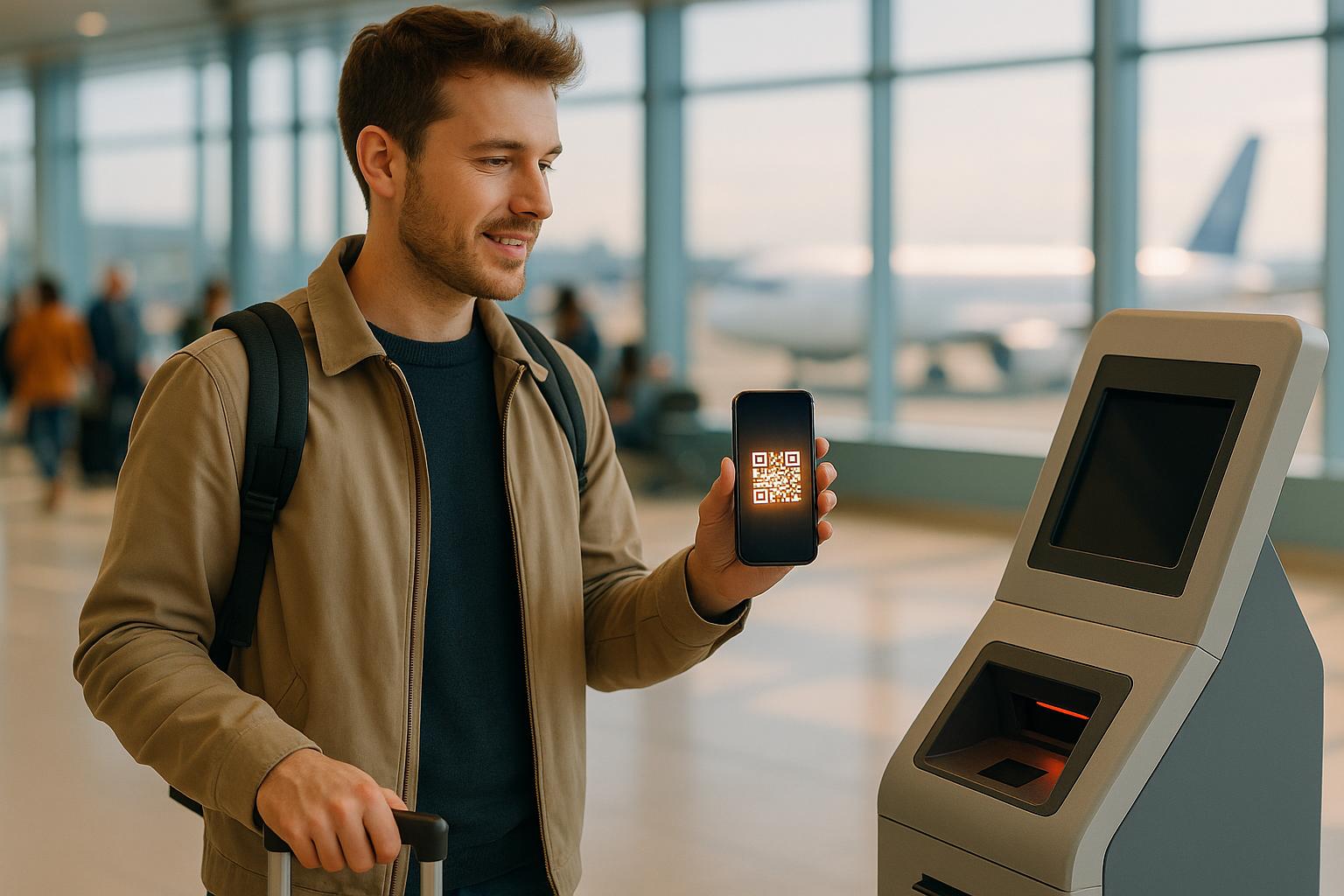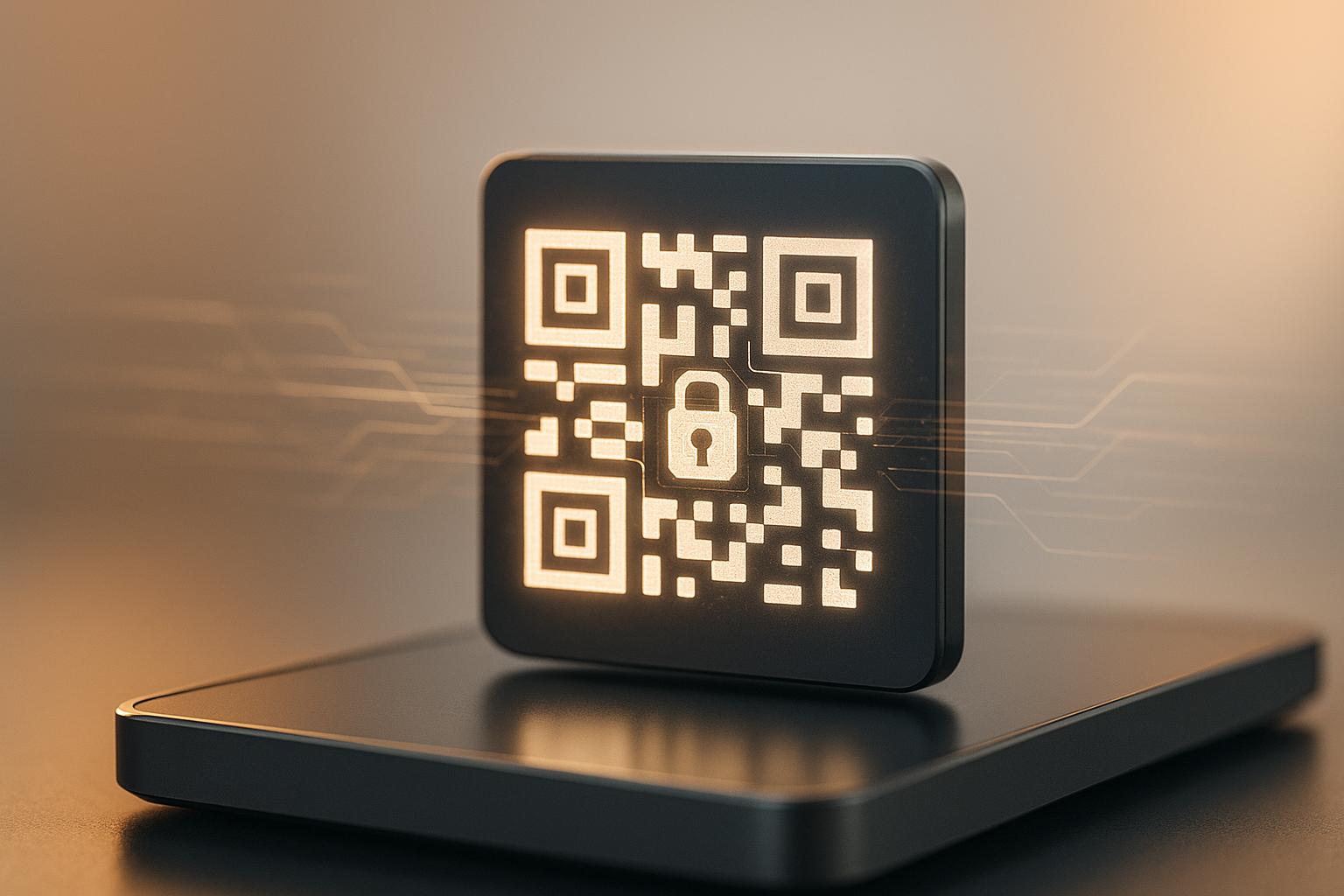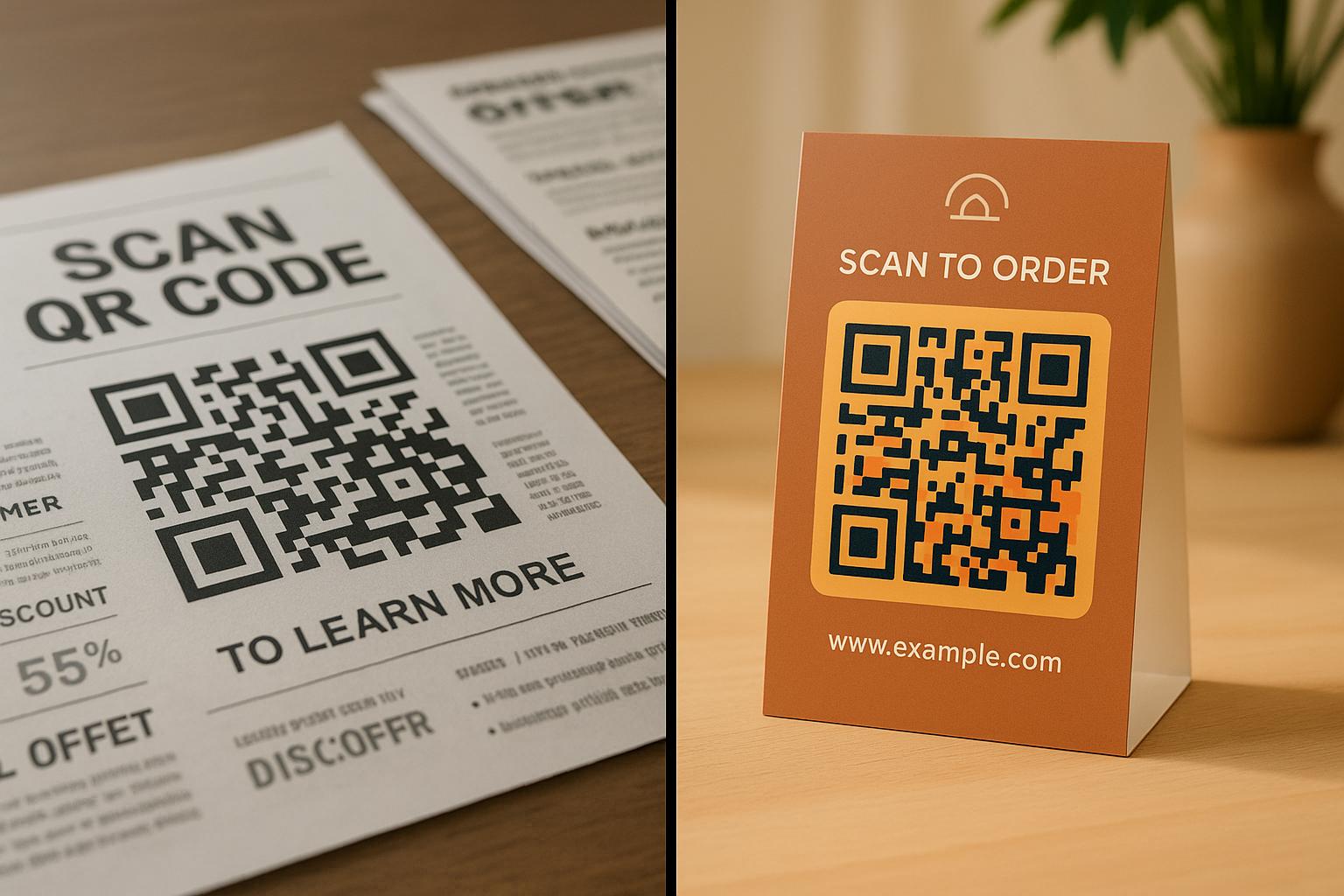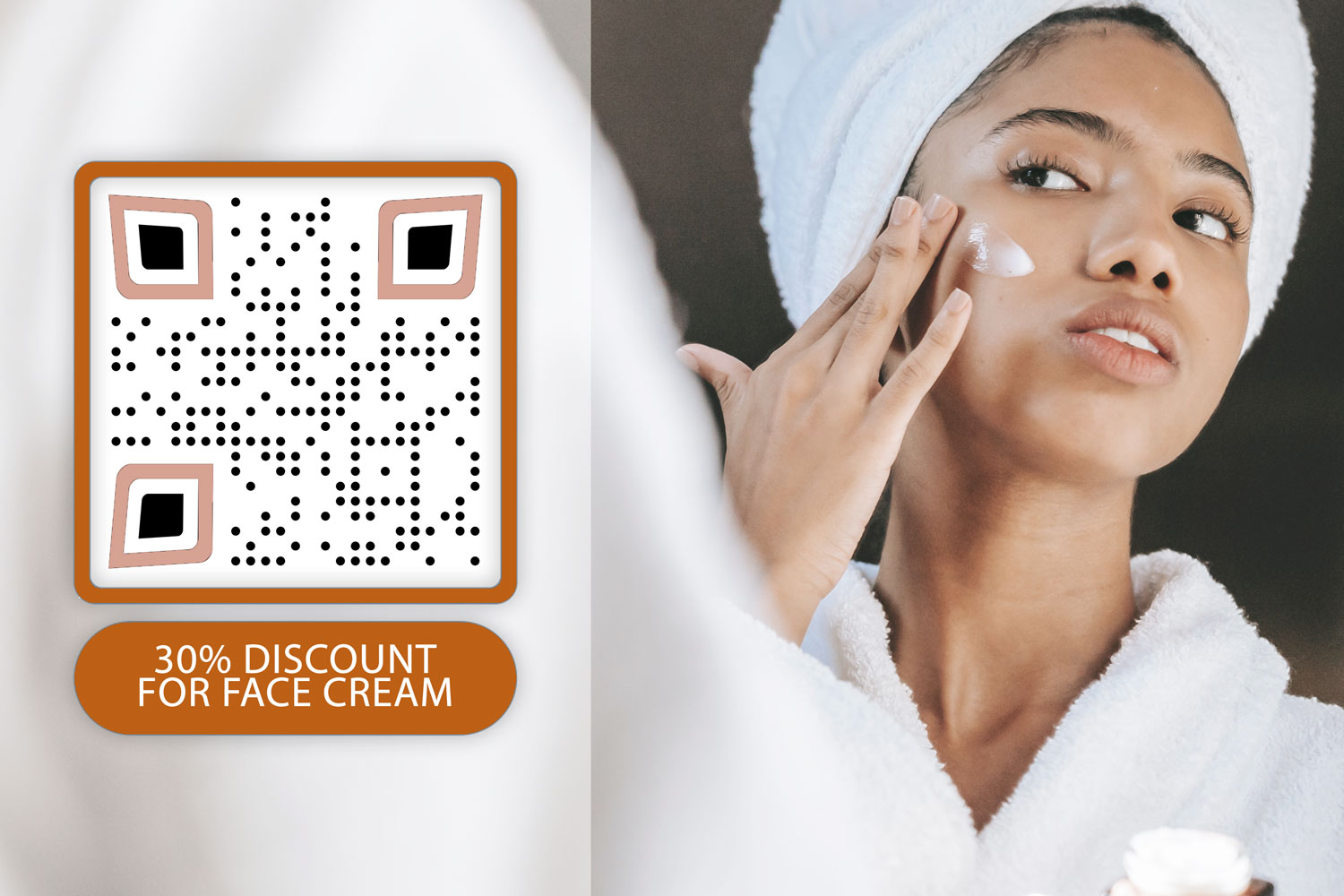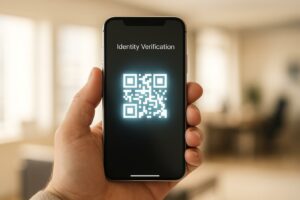QR codes have transformed travel by making it faster, safer, and more convenient. Here’s how:
- Ticketing & Check-Ins: QR codes speed up processes for boarding passes, attraction tickets, and hotel check-ins. They reduce wait times and eliminate paper tickets.
- Navigation & Accessibility: Scannable codes provide real-time transit updates, interactive maps, and even language translations, helping travelers explore with ease.
- Interactive Content: Museums and landmarks use QR codes for multimedia guides, augmented reality experiences, and personalized tours, replacing static displays.
- Payments & Offers: Contactless QR payments ensure secure transactions, while businesses use them for loyalty programs and personalized promotions.
- Eco-Friendly Solutions: By replacing printed materials, QR codes save costs and reduce waste, aligning with modern travel demands.
- Security & Trust: Dynamic QR codes offer encryption, real-time updates, and analytics, ensuring data safety and building user confidence.
QR codes are now a must-have in the travel industry, bridging physical and digital experiences while meeting the needs of today’s tech-savvy travelers.
5 TRIED AND TRUE TIPS WHEN USING QR CODES FOR TOURISM AND TRAVEL
Making Ticketing and Check-Ins Faster
QR codes have revolutionized ticketing and check-in processes, cutting down on delays and simplifying travel documentation.
Contactless Tickets for Transportation and Attractions
Contactless ticketing has made accessing transportation and attractions faster and easier. By using QR codes, travelers no longer need physical tickets – just a quick scan of their smartphone grants them entry.
Take the Louvre in Paris, for example. In May 2025, the museum adopted QR codes for ticketing, speeding up entry times and adding a layer of security for its millions of annual visitors. Plus, storing tickets digitally means no more worries about losing them or dealing with damaged barcodes.
Public transportation systems have also embraced QR codes with impressive results. Amtrak, for instance, offers QR code-based boarding passes, cutting down on wait times and eliminating the need for paper tickets. Travelers can store their tickets digitally, receive real-time updates, and even make changes instantly.
In Singapore, the ICA app uses QR codes to replace traditional passport checks at immigration. What used to be a time-consuming process is now as simple as a quick scan.
Dynamic QR Codes for Real-Time Updates
While static QR codes are great for basic ticketing, dynamic QR codes take things up a notch by offering flexibility and real-time updates. These codes allow changes to ticket or reservation details without needing a reprint. For example, gate changes, seat assignments, or updated schedules can be pushed directly to a traveler’s existing QR code. London’s rail system uses this technology to send personalized updates, such as disruption alerts, multi-leg trip plans, and details on the next available trains.
For businesses, tools like Pageloot’s dynamic QR code generator make it easy to create codes that can be edited and updated. This platform lets you modify URLs, update information, and even track performance – all without generating new codes.
The financial impact of QR code adoption is huge. By 2028, QR code payments in transportation are expected to hit $17.7 billion. This technology isn’t just a convenience anymore – it’s becoming a critical part of the travel infrastructure. Beyond transportation, dynamic QR codes are being used in hotel and event check-ins, further improving the travel experience.
QR Codes for Hotel and Event Check-Ins
QR codes are also transforming hotel and event check-ins, making them faster and more efficient. Guests receive their QR codes via email or an app before their arrival. At the venue, they simply scan the code at a kiosk or show it to staff for instant verification. This eliminates the need for key cards, printed confirmations, or lengthy check-in lines.
Hotels aren’t the only ones benefiting. Event organizers are finding QR codes invaluable for crowd management and communication. Dubai’s Roads and Transport Authority (RTA), for example, uses QR codes at bus stops to provide live schedule updates through the S’hail app. This shows how QR codes can enhance the entire travel ecosystem.
Dynamic QR codes are especially helpful for event organizers. Last-minute changes, like venue updates or schedule adjustments, can be communicated instantly through the same QR code attendees already have. To ensure a smooth experience, businesses should thoroughly test QR codes for compatibility across devices and include clear instructions like “Scan for Entry” to guide users.
The numbers don’t lie – 41% of boarding passes are now mobile. Travelers not only accept digital solutions but actively prefer them. From airlines to hotels and events, QR codes are becoming a standard feature, improving experiences by reducing delays and simplifying processes. For businesses, adopting QR codes isn’t just an added perk – it’s quickly becoming a must-have.
If you’re ready to create a QR code for your travel business, consider how dynamic codes can give your customers the flexibility they need while streamlining your operations. What once felt futuristic is now an everyday expectation for modern travelers.
Improving Navigation and Accessibility
Getting around unfamiliar places can be overwhelming. QR codes are stepping in to make navigation easier and more user-friendly for everyone.
Interactive Maps and Real-Time Transit Updates
QR codes are changing how travelers access navigation tools and transit updates. By scanning a code, users can instantly pull up interactive maps and real-time transit information right on their smartphones.
Take Dubai’s Roads and Transport Authority (RTA) as an example. They’ve placed QR codes at bus stops across the city, linking directly to live bus schedules via the S’hail app. Commuters can scan the code to check when their bus is arriving, cutting down on wait times and eliminating uncertainty.
In London, the rail system uses QR codes a bit differently. They offer personalized trip planning and disruption alerts through dynamic QR codes, which can be updated instantly. This means any changes – like delays or route adjustments – are reflected in real time without needing to replace the physical QR code.
QR codes also play a role in guiding travelers at busy transit hubs like airports and train stations. For instance, scanning a code at an airport terminal might provide directions to the nearest gate, current security line wait times, or a list of nearby amenities.
These advancements don’t just make navigation smoother – they also help break down language barriers.
Language Translation Through QR Codes
QR codes are tackling one of the biggest challenges in travel: language differences. They provide instant access to translated information, which is especially helpful in tourist-heavy areas where visitors speak a variety of languages.
The numbers are striking: 20% of the U.S. population speaks a language other than English at home. Internationally, the percentage of non-native speakers can be even higher. A creative example comes from Canley Vale Public School in Sydney, where QR codes were used during COVID-19 to translate important notices into seven community languages. Parents could scan the codes to hear the information read aloud in their preferred language.
Museums are also leveraging QR codes to make exhibits more accessible. Visitors can scan codes for audio tours and multimedia materials in multiple languages. Some advanced multi-URL QR codes even detect the user’s language or location automatically, ensuring that a single code can serve a diverse audience without requiring manual adjustments.
Branded QR Codes for Trust and Recognition
While real-time updates and language support are game-changers, building trust with users is just as important. Travelers are often hesitant to scan unfamiliar codes, especially in new environments. Branded QR codes – featuring logos, consistent colors, and recognizable designs – help establish credibility and reassure users that the source is legitimate.
For instance, the New York City subway system uses brightly colored QR codes integrated with the NaviLens app. These codes are designed to be highly visible, even for visually impaired users, and provide information like real-time arrivals and boarding areas in up to 34 languages when scanned.
For businesses in the travel industry, a QR code generator with logo can help create codes that align with their brand identity while delivering practical benefits. Placing these codes in high-traffic areas, optimizing them for mobile use, and including accessibility features like high contrast designs or braille labels makes travel more inclusive for all users.
Creating Better Visitor Experiences with Interactive Content
Travelers today can access immersive multimedia experiences, personalized tours, and even augmented reality (AR) features with just a quick scan of a QR code. This modern approach is replacing the need for static plaques and cumbersome guidebooks, transforming how people explore destinations.
QR Codes for Multimedia Guides and AR Experiences
Museums, historical landmarks, and cultural sites are embracing QR codes to deliver engaging content far beyond what traditional signage can offer. By scanning a code, visitors can instantly access videos, audio guides, expert insights, and AR reconstructions right on their smartphones.
For instance, museums in Spain and Thailand have adopted QR codes for self-guided tours, leading to increased visitor interaction and glowing feedback. These codes provide behind-the-scenes videos, detailed audio guides, and expert commentary, making visits more engaging without the need for bulky equipment.
Using tools like a video QR code generator, venues can link visitors to documentary footage about historical events. Similarly, PDF QR codes can share architectural blueprints or in-depth documents, while an MP3 QR code generator can offer audio interviews or ambient soundscapes to enrich the atmosphere.
This approach also eliminates the need for costly, high-maintenance audio guide devices. Instead, visitors use their own smartphones – a key advantage when 70% of travelers worldwide have identified health and safety as a top priority. By moving beyond static displays, QR codes allow for personalized and interactive tours that cater to individual preferences.
Personalized Tours and Scavenger Hunts
QR codes are a game-changer when it comes to creating tailored experiences for visitors. By placing these codes strategically throughout a venue or city, operators can design unique tour routes or even interactive scavenger hunts.
For example, scanning a QR code might reveal clues, unlock new locations, or provide content based on specific interests. A family visiting a science museum could follow a child-friendly trail, while history buffs might dive deeper into the stories behind the exhibits. These personalized experiences not only boost engagement but also encourage exploration and repeat visits, seamlessly blending with the growing trend of digital interactivity.
Travel businesses are also finding inventive ways to use QR codes. Codes printed on tickets can unlock exclusive content or special deals, while those on flyers can guide visitors to hidden gems or local attractions – adding an extra layer of discovery to the overall experience.
Dynamic QR Codes for Updating Content
The ability to update content in real time is a major advantage of dynamic QR codes. Unlike static codes, dynamic QR codes let operators refresh exhibit details, add new language options, or update multimedia content without having to replace the physical code itself. This flexibility eliminates the expense and hassle of reprinting traditional materials.
For visitors, this means they always have access to the latest information during their trip. Dynamic QR codes also help reduce the need for printed brochures, maps, and guides, supporting a more eco-friendly approach.
Analytics take this a step further by tracking which codes are scanned most often. With this data, operators can identify popular content, refine exhibits, and tailor future offerings to better meet visitor preferences – all of which contribute to greater satisfaction.
Seasonal updates are another benefit. A botanical garden, for instance, can use QR codes to highlight current blooms, while historical sites can add special features during anniversaries or commemorative events. This keeps the experience fresh and exciting for repeat visitors.
To make these interactive features simple to implement, you can create a QR code that links directly to dynamic, multimedia content. This ensures visitors always have access to the most up-to-date and engaging information.
Enabling Contactless Payments and Personalized Offers
QR codes are reshaping how the travel industry handles transactions and connects with customers. By offering cash-free, secure, and touchless payment options, these digital tools simplify the payment process while also opening the door for more personalized customer engagement.
Contactless Payments in Travel
The rise of contactless payments has brought a major shift to the travel world. QR codes make this possible by linking users directly to payment screens, allowing for fast transactions without physical interaction with terminals. Importantly, these payments don’t require sharing personal account details, and all payment data is encrypted – giving travelers peace of mind against fraud risks.
The global uptake of QR-based payments highlights their importance. For instance, Brazil’s Central Bank integrated QR codes into its PIX system, which, by 2023, had become the country’s leading payment method. Similarly, Singapore’s Monetary Authority rolled out SGQR+ to unify various digital payment options. In Southeast Asia, a staggering 93% of consumers now use cashless payment methods, including QR codes, with usage increasing by 43.20% since 2022. For tourism businesses, adopting QR code payments often leads to higher transaction rates. Beyond convenience, these payment methods also pave the way for personalized travel offers that cater to individual preferences.
Delivering Personalized Promotions and Loyalty Programs
QR codes are proving to be game-changers for delivering tailored promotions and managing loyalty programs. Research shows that 79% of businesses leverage dynamic QR codes to create personalized customer interactions. By analyzing customer data, travel companies can design rewards and discounts that align with individual preferences and past bookings. For example, hotels and airlines use these codes to simplify loyalty programs, offering rewards and discounts through a single scan.
In the U.S., QR code usage grew by 26% following the pandemic. Real-world examples back this up: Marriott Bonvoy members can earn points for hotel stays by interacting with QR codes, redeemable for perks like free nights or travel upgrades. Similarly, Delta SkyMiles uses QR codes to track frequent flyer activity, allowing members to exchange miles for flights, upgrades, or discounts. With 75% of consumers saying they prefer brands with loyalty programs that reward them, dynamic QR codes have become a powerful tool for boosting customer engagement and retention.
Marketing Automation and Analytics for Campaigns
QR codes also provide travel businesses with valuable insights into customer behavior. Analytics tools can track scan locations, times, device types, and even user demographics. This data helps businesses understand travel trends and preferences, enabling them to create more targeted rewards and loyalty initiatives.
Armed with these insights, companies can fine-tune their promotional strategies. Integration tools allow businesses to reach travelers through email, SMS, and push notifications – keeping communication consistent throughout the customer journey. AI-powered algorithms can even recommend personalized travel options based on past interactions and scanning habits. Platforms like Pageloot take this one step further, offering real-time analytics and editable QR codes. This flexibility means businesses can update promotions quickly to reflect seasonal trends or special events without the need to reprint materials.
For those looking to launch comprehensive QR code campaigns, a free QR generator with built-in analytics can help track performance and identify what works best – whether it’s specific locations, times, or types of offers. Additionally, incorporating dynamic QR codes with verification features ensures a secure experience, balancing safety and ease of use to build customer trust.
sbb-itb-74874c9
Environmental benefits and cost savings with QR codes
As travelers increasingly seek both efficiency and eco-friendly options, QR codes have emerged as a game-changer, offering a blend of convenience and environmental responsibility. By replacing printed materials like maps, brochures, tickets, and guidebooks with digital alternatives, QR codes help travel businesses cut costs and reduce waste, all while integrating seamlessly with modern digital tools.
Reducing printed materials
One of the most visible impacts of QR codes is the reduction in printed materials. Instead of relying on paper maps, brochures, or tickets, travelers can now access the same information with a simple scan. Predictions for 2023 suggested that widespread adoption of QR codes could slash paper usage by as much as 50%.
"QR Codes provide a seamless, paperless means of accessing information, significantly reducing the environmental impact associated with traditional travel materials." – Isabella
National parks and wildlife refuges are leading this shift. For example, instead of handing out printed guidebooks, many parks now use QR codes to provide visitors with up-to-date details about local wildlife, plants, and ecosystems. Hotels are also making the switch, replacing printed room service menus, attraction guides, and check-in materials with QR code-based digital access. Airlines have followed suit, integrating QR codes into boarding passes and in-flight materials, further reducing paper dependency.
Real-time analytics for resource optimization
Beyond environmental benefits, QR codes offer travel businesses the ability to manage resources more effectively through real-time analytics. These tools reveal how customers engage with services, enabling smarter decisions about where to allocate resources. The numbers tell the story: QR code adoption has surged by 433% in the past year, with QR code generation growing by 238% over the last few years.
By leveraging real-time data, businesses can fine-tune their strategies. For instance, a tour company might test QR codes on flyers versus posters to determine which placement drives more engagement. Platforms like Pageloot take this a step further, offering detailed analytics that track scan rates, peak usage times, and geographic trends. This data enables businesses to adjust staffing, inventory, and promotions to align with demand, creating a smoother and more efficient operation.
The ability to monitor and adapt based on QR code performance not only reduces waste but also enhances the overall customer experience. By using these insights to refine their approach, travel companies can stay ahead of changing consumer preferences while reinforcing their commitment to sustainability and quality. This dual focus on efficiency and eco-consciousness is reshaping modern travel for the better.
Security and Building Traveler Trust
As the travel industry embraces digital advancements, ensuring the security of QR code solutions has become essential for protecting sensitive traveler information. When travelers scan QR codes at airports, hotels, or attractions, they’re sharing personal details – like payment information, personal data, or even location tracking. This trust hinges on secure systems, and modern QR code technology has risen to the challenge with stringent security measures.
Dynamic QR codes, in particular, offer a level of protection that static QR codes cannot. Static codes store fixed data, making them vulnerable to replication and fraud. On the other hand, dynamic QR codes incorporate encryption, access controls, and deactivation features, providing a strong defense against cyber threats. Additionally, real-time tracking and analytics allow businesses to monitor QR code usage and identify unusual activity – such as scans from unexpected locations – which could signal potential security breaches. With global digital payment transactions projected to exceed $10 trillion by 2025, integrating secure QR code technology into backend systems is no longer optional – it’s a must.
Building Trust with Editable and Monitored QR Codes
Reliability and transparency are at the heart of building traveler trust. In the travel industry, where plans can change rapidly, businesses need tools that provide real-time updates. Dynamic QR code platforms, such as those offered by Pageloot, allow companies to update QR code content instantly without reprinting materials. This ensures travelers always have access to the most up-to-date information, whether it’s a revised itinerary or a change in service offerings.
For instance, hotels or tour operators can update QR code content to reflect seasonal promotions or new services without incurring the cost or waste of reprinting materials. Platforms like Pageloot also provide detailed analytics, showing exactly when and where QR codes are scanned. This data helps travel companies optimize operations – streamlining check-ins, managing crowd flow, and even improving staffing efficiency. These capabilities not only enhance the traveler experience but also reinforce the security framework that underpins QR code usage.
To maintain trust, travel companies should prioritize partnering with QR code providers that have a proven track record of security and clear data privacy policies. Adding encryption, authentication protocols, and monitoring tools further protects data from misuse and ensures content integrity.
How to implement QR codes in travel
Integrating QR codes into travel services can enhance the customer experience while keeping costs low and implementation straightforward. Start by identifying how QR codes can fit into your operations – whether it’s for digital tickets, maps, or promotional campaigns. From there, select the right tools and set up tracking systems to measure performance. These steps align with the broader strategies discussed earlier, helping you deliver a seamless experience for travelers.
How to create QR codes for travel
The first step in creating QR codes for travel is understanding your specific needs. Are you using them for digital tickets, interactive maps, or promotional offers? Once you’ve defined the purpose, decide between static and dynamic QR codes. Static codes are great for permanent information, while dynamic codes are ideal for frequently changing details, such as travel schedules or event updates.
To create a QR code, input your destination URL, choose the appropriate type, and generate the code. For travel businesses, dynamic QR codes are especially useful since they allow updates without needing to reprint materials. These codes can be placed strategically in high-traffic areas like hotels, public transportation, brochures, or tickets, offering multilingual information and boosting customer engagement.
Incorporating QR codes into both print and online marketing materials is another smart move. For instance, you can direct travelers to your website or social media platforms to build a community and keep them informed. Before rolling out any QR codes, always test them on different devices and in various lighting conditions to ensure they work seamlessly.
Customizing and branding for impact
A plain black-and-white QR code might not grab attention, especially in busy travel settings. Customizing your QR codes can make them more eye-catching and align them with your brand’s identity. Adding elements like logos, brand colors, or unique design templates can transform a simple QR code into a powerful marketing tool.
For instance, travel companies can use bold colors, shapes, or logos to make their QR codes more visually appealing while ensuring they remain scannable. Just be sure to maintain enough contrast between the code and its background for reliable scanning, even in low-light conditions.
Placement is equally important. Use clear calls-to-action, such as “Scan for a 20% discount on tours” or “Access multilingual audio guides instantly,” to encourage interaction. Think about the environment where your QR codes will appear. Codes on vehicles may need to be larger than those on business cards or flyers. Refer to tools like the QR code size guide to determine the best dimensions based on placement and scanning distance.
Consistency across all QR code designs and placements reinforces your brand identity. When travelers see the same branded QR codes on your marketing materials, transportation, and on-site displays, they’re more likely to trust and engage with them.
Tracking and optimizing QR code campaigns
Tracking how well your QR codes perform is key to improving your marketing efforts and enhancing the traveler experience. Without analytics, you might miss valuable insights into customer behavior and potential areas for improvement.
Dynamic QR codes are essential for tracking performance. They allow you to monitor metrics like total scans, unique visitors, geographic locations, and conversion rates – helping you understand how users interact with your codes. On average, QR code campaigns see a 12.8% click-through rate, outperforming many traditional digital ads.
Real-world examples illustrate their effectiveness. The M+ Museum in Hong Kong used dynamic QR codes throughout its galleries to connect physical exhibits with digital content. This initiative resulted in 148,000 scans and engaged 113,000 visitors. Similarly, New Brunswick tourism achieved a 1.77% engagement rate by placing QR codes on direct mail flyers and CTV ads, leading users to their website and encouraging contest participation.
To optimize your campaigns, focus on improving visibility and engagement. Use strong calls-to-action, place QR codes in high-traffic areas, and ensure landing pages are mobile-friendly with quick load times. Tools like Google Analytics can provide deeper insights into which locations or materials drive the most valuable interactions.
Platforms like Pageloot offer detailed analytics dashboards, showing when and where QR codes are scanned. This data can help travel businesses streamline operations, from managing check-ins and crowd flow to optimizing staffing during busy periods.
Continuous improvement is crucial. Regularly monitor seasonal trends, test different placements, and update content based on user feedback. With dynamic QR codes, you can make real-time adjustments without reprinting materials, allowing you to stay flexible and responsive to travelers’ needs.
Conclusion
QR codes have reshaped the travel industry, offering ease, speed, and tailored experiences that cater to both travelers and businesses. From seamless ticketing and hassle-free check-ins to interactive maps and instant updates, QR codes are now a cornerstone of modern travel.
Their influence is undeniable. With 70% of global travelers prioritizing health and safety, QR codes meet the demand for contactless solutions in today’s travel landscape. Countries such as Brazil, Thailand, and Spain showcase how QR codes can enhance tourism while simplifying operations.
One of the standout features of QR codes is their adaptability. Dynamic QR codes allow real-time updates to schedules, promotions, or information without requiring physical reprints. Whether they appear on tickets, vehicles, or promotional flyers, they bridge the gap between the physical and digital worlds, enriching the travel experience.
But their benefits go beyond just operational improvements. QR codes also support sustainability efforts by cutting down on paper use and leveraging real-time data to allocate resources more effectively. This aligns perfectly with the growing environmental awareness among travelers, helping the industry move toward greener practices.
FAQs
How do QR codes make travel transactions more secure and protect personal information?
QR codes play a key role in making travel transactions safer by using encrypted data storage to protect personal information from being accessed without permission. Dynamic QR codes take this a step further by offering real-time updates and the option to change linked content, minimizing risks like outdated or potentially harmful links.
For added security, travelers should stick to scanning QR codes from reliable sources and steer clear of unfamiliar ones. When combined with the security measures of encrypted and dynamic QR codes, these habits greatly lower the chances of phishing attacks or data theft while traveling.
How can travel businesses use QR codes to create personalized experiences for tourists?
Travel businesses can leverage QR codes to create more personalized and engaging experiences for their customers. By scanning these codes, travelers can access customized itineraries, exclusive discounts, or tailored recommendations for dining, shopping, and activities that match their interests, adding an extra layer of enjoyment to their trips.
Beyond personalization, QR codes also streamline practical aspects of travel. They can facilitate contactless check-ins, provide instant language translations, and give access to interactive maps. These features not only make traveling more convenient but also enhance the overall experience, helping businesses leave a lasting impression on their customers.
What are dynamic QR codes, and how do they enhance travel experiences compared to static QR codes?
Dynamic QR codes have become an incredibly useful tool in the travel industry, offering the flexibility to update linked content in real-time without altering the code itself. This means travelers can always access up-to-date information, whether it’s revised schedules, event details, or exclusive promotions.
What sets dynamic QR codes apart from static ones is their adaptability. Static QR codes are fixed, so any changes require reprinting, which can be costly and time-consuming. Dynamic QR codes, on the other hand, eliminate that hassle. They also provide insightful analytics, such as how many times the code is scanned, where it’s scanned, and even patterns in user behavior. This data helps travel businesses fine-tune their services and marketing strategies.
With these capabilities, dynamic QR codes are a smart choice for creating smoother, more efficient, and tailored travel experiences.

